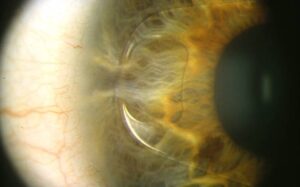Eye diseases
Hyperopia

What is hyperopia?
Hyperopia is a refractive error, where images are focused behind the retina, rather than on it, thus causing blurred vision mainly up close. Moreover, if it is associated with astigmatism, vision may be less clear at a distance as well.
Having shorter or smaller eyes than usual, as well as having a cornea that is too flat, can cause this vision problem. We must bear in mind that we are all farsighted at birth and that the eye also develops as we grow. Therefore, it is a very common refractive defect in childhood, although the eye will be farsighted throughout life (in approximately 10% of the population), if the eyeball grows less than necessary.
Especially in the event of high hyperopia, the risk of other associated eye diseases, such as strabismus or glaucoma, is higher. You should also take into account that some surgeries, such as cataract surgery, can be more complex due to the smaller size of the eye, hence it is important that they are performed by an expert ophthalmologist.
Symptoms
Usually, after prolonged efforts to force a close look, you may notice eye strain or eye fatigue and even headache and eye pain, which are more frequent the greater your degree of hyperopia and, especially, if it is not well corrected. This discomfort can result in greater difficulty concentrating and maintaining clear vision while reading, using your mobile phone or performing other tasks at close range.
Hyperopia should not be confused with presbyopia or “old eyes”, which also causes blurred near vision and these associated symptoms, although it usually appears from the age of 40-45 and is due to the loss of elasticity of the lens (the eye’s natural lens, which allows us to focus).



